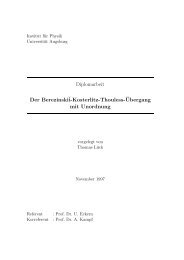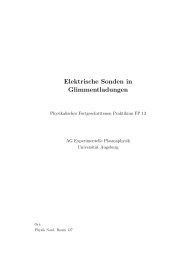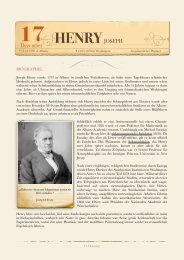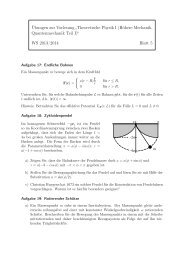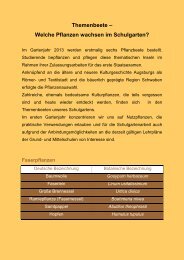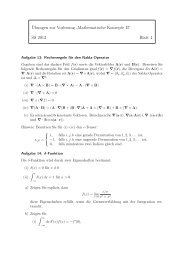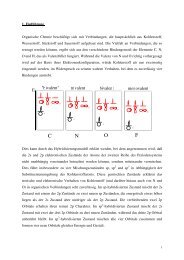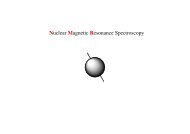Relativistic thermodynamics: Always look back - Institut für Physik
Relativistic thermodynamics: Always look back - Institut für Physik
Relativistic thermodynamics: Always look back - Institut für Physik
You also want an ePaper? Increase the reach of your titles
YUMPU automatically turns print PDFs into web optimized ePapers that Google loves.
news & views<br />
electromagnetism 10 , where the particle<br />
and current densities are spatial densities.<br />
They can, however, be represented as a<br />
tensor field, the so-called 4-current, and<br />
this makes the Maxwell theory compatible<br />
with Einstein’s theory of relativity. The<br />
same remark applies to all Yang–Mills<br />
gauge theories 11,12 , both quantum and<br />
non-quantum.<br />
Now, because the velocity of light<br />
is finite, a given observer at each point<br />
P(t) on his or her world line — the path<br />
on which the observer travels trough<br />
spacetime — will never have access to<br />
the whole 3D region R(t), but only to the<br />
interior of their past lightcone; this is a 4D<br />
subdomain of the 4D spacetime, and its<br />
intersection with R(t) is reduced to P(t). As<br />
a consequence, considering fields defined<br />
over R(t) and densities with respect to a 3D<br />
volume element defined over R(t) may not<br />
seem really physical. Dunkel, Hänggi and<br />
Hilbert 4 therefore suggest that R(t) should<br />
be replaced by the 3D past lightcone of the<br />
observer at point P(t). (This past lightcone<br />
reduces to R(t) when c tends to infinity, as<br />
is the case in the Galilean regime.)<br />
This idea seems indeed reasonable<br />
and it has the advantage of being<br />
arguably more physically sound than<br />
the conventional procedure. But still, it<br />
remains to be seen where this suggestion<br />
will lead us. Among the open issues<br />
are the following: first, from a purely<br />
mathematical or physical perspective, there<br />
is no problem whatsoever with integrating<br />
on a lightcone. However, it is impossible<br />
to average on a lightcone in an intrinsic,<br />
observer-independent manner (this is<br />
because lightcones are so-called null<br />
surfaces 13 , on which the normal vectors are<br />
also tangent vectors — remember that the<br />
relativistic line-element is not necessarily<br />
positive). All lightcone averages therefore<br />
involve an extra structure, typically the<br />
choice of an observer, and it is not clear if<br />
this constitutes a severe limitation or not.<br />
Second, when following in the footsteps<br />
of Dunkel, Hänggi and Hilbert 4 , it is<br />
tempting to revisit all Yang–Mills theories<br />
and connect them with lightcone densities.<br />
Will this be possible? And will it have any<br />
influence on how we view quantization?<br />
The future will tell.<br />
❐<br />
Fabrice Debbasch is in the Equipe de Relativité,<br />
Gravitation et Astrophysique (ERGA) of the<br />
Laboratoire d’Etude du Rayonnement et de la<br />
Matière en Astrophysique (LERMA), Université<br />
Paris 6, 3 rue Galilée, 94200 Ivry, France.<br />
e-mail: fabrice.debbasch@gmail.com<br />
References<br />
1. Landau, L. D. & Lifshitz, E. M. Fluid Mechanics (Pergamon, 1987).<br />
2. Landau, L. D. & Lifshitz, E. M. Theory of Elasticity<br />
(Pergamon, 1986).<br />
3. Israel, W. in <strong>Relativistic</strong> Fluid Dynamics (eds Anile, A. &<br />
Choquet-Bruhat, Y.) 152–210 (Lecture Notes in Mathematics,<br />
Vol. 1385, Springer, 1987).<br />
4. Dunkel, J., Hänggi, P. & Hilbert, S. Nature Phys.<br />
5, 741–747 (2009).<br />
5. Batchelor, G. K. An Introduction to Fluid Dynamics (Cambridge<br />
Univ. Press, 1967).<br />
6. Wald, R. M. Space, Time and Gravity (Univ. Chicago Press, 1992).<br />
7. Debbasch, F. Physica A 387, 2443–2454 (2008).<br />
8. Debbasch, F. & van Leeuwen, W. Physica A<br />
388, 1079–1104 (2009).<br />
9. Debbasch, F. & van Leeuwen, W. Physica A<br />
388, 1818–1834 (2009).<br />
10. Jackson, J. D. Classical Electrodynamics (Wiley, 1975).<br />
11. Dubrovin, B. A., Novikov, S. P. & Fomenko, A. T. Modern<br />
Geometry: Methods and Applications (Springer, 1984).<br />
12. Itzykson, C. & Zuber, J. B. Quantum Field Theory<br />
(Dover, 2006).<br />
13. Wald, R. M. General Relativity (Univ. Chicago Press, 1984).<br />
SAND SWIMMERS<br />
In silica in silico<br />
Swimming and flying are complicated<br />
processes to model, but at least the laws<br />
of fluid dynamics are known. In contrast,<br />
sand is a trickier medium to understand<br />
than water or air, because it can behave<br />
as a solid or as a fluid. Moreover, the<br />
presence of a ‘swimmer’ — such as the<br />
sand skink Plestiodon reynoldsi (pictured),<br />
seeking refuge from the heat of the<br />
Sun — changes the local properties of<br />
the sand, creating pockets of air and<br />
affecting the force chains between<br />
the granules. Consequently, there are<br />
no analytical equations of motion. To<br />
better understand the mechanism of<br />
swimming through a solid yet shifting<br />
medium, Takashi Shimada and colleagues<br />
have simulated the locomotion of<br />
a sand swimmer (Phys. Rev. E 80,<br />
020301; 2009), using a ‘push‐me‐pullyou’<br />
model (pictured moving to the<br />
right) introduced by Joseph Avron and<br />
colleagues (New J. Phys. 7, 234; 2005).<br />
In essence, the push‐me‐pull‐you<br />
model describes two disks connected<br />
by a spring. The disks inflate and shrink.<br />
To move forwards in fluid‐like sand,<br />
the smaller anterior disk inflates as<br />
the spring lengthens. The initially fully<br />
inflated posterior disk acts as an anchor<br />
in solid‐like sand. Once the anterior disk<br />
is fully inflated, it then acts as the anchor<br />
while the posterior disk shrinks and<br />
moves forwards as the spring contracts.<br />
To complete the move, the posterior<br />
disk inflates again, ready for the next<br />
stroke. Thus, a sand swimmer must deal<br />
with solidification near the anchor and<br />
fluidization near the moving disk at the<br />
same time.<br />
The simulation’s surprising result is<br />
that the optimal swimming frequency for<br />
maximum velocity is different from that<br />
for maximum efficiency. For example, if<br />
the swimmer moves too fast, the large<br />
voids created cause the swimmer to<br />
lose traction and slip. Hence the most<br />
efficient swimmer swims slowly. But<br />
move too slowly and the sand resolidifies<br />
before any forward motion<br />
can be completed. Unexpectedly, the<br />
simulation also provides information on<br />
the fundamental time scales associated<br />
with granular packing.<br />
MAY CHIAO<br />
© ALESSANDRO CATENAZZI<br />
nature physics | VOL 5 | OCTOBER 2009 | www.nature.com/naturephysics 709<br />
© 2009 Macmillan Publishers Limited. All rights reserved



